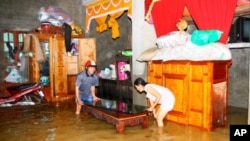Vietnam is reeling from disastrous flooding that has devastated other countries in the region. Vietnamese officials say at least 105 people have been killed by the flood waters. However, different areas of the country are faring better than others.
The floods in Vietnam’s Mekong Delta region peaked in the middle of September but the water still has not drained away.
Lotta Sylwander, representative for the United Nation’s Children’s Fund in Vietnam, says the flooding there is the worst in a decade.
“Usually in An Giang no flood water reaches the capital but this time it is completely inundated with water. Basically, the whole province is covered so it was really, really bad. That meant that all the access roads were covered. Basically almost all the schools were closed, it was difficult for people to get to hospitals and clinics because people had to go there by boat or they couldn’t get there at all,” Sylwander stated.
Nearly 600,000 people in seven provinces were affected by the flooding, which reached up to six meters in some areas.
The United Nations says 72 of the country’s dead are children, many of them infants or children who cannot swim.
Sylwander says one of the biggest problems is people going about their daily business in spite of the dangerously high water levels.
“They are used to crossing waterways and sometimes they can even swim and they are used to putting their school bags on their heads and crossing a stream or something but the thing is there is so much more water this time and the current is very strong so the kids are carried away when they are normally not,” Sylwander said.
The devastation was not only felt in the south. A few weeks after floods hammered the Mekong, heavy rainfall triggered flash floods in the center of the country. Vietnamese officials say 20 people have been killed there, most of them in the past week.
Around 30,000 people have been evacuated from their homes.
Despite facing a similar disaster, Bhupinder Tomar, from the International Federation of the Red Cross, says communities in the center of the country are more resilient than the ones in the south.
“In the Mekong people live with floods because it’s beneficial to them. In the center, the floods are flash floods and it affects different areas depending on where the concentration is so the resilience is much lower. Long term the impact usually is that it destroys a lot of infrastructure and housing. The recovery is quicker in the center because the area affected is not so large,” Tomar said.
Tomar says the long term impact in central provinces is the destruction of infrastructure and housing, however recovery in the center is quicker because the affected area is not so large. In Quang Nam province alone, the damage was likely to cost around five million dollars, according to news reports.
The bill is likely to be large in Mekong Delta provinces too. Last week, the state-run newspaper Vietnam News said floods in the Mekong Delta have caused more than $135 million in damages since they began in late August.
The difference for farmers in the Mekong, Tomar says, is that they rely on flooding to reinvigorate their paddy fields. This means the impact of the floods will probably be beneficial to them in the long term. “I am sure in a year and a half’s time these floods will actually be very productive because it will have brought new sediment and new soil which will be very useful for the farmers,” he said.
As flood waters begin to recede from the upper reaches of the Mekong, Sylwander says she thinks the situation will improve. Although flood water is still rising in provinces further down the Mekong, they have had longer to prepare for the emergency.
That does not mean the disaster is over. With one rice harvest destroyed, many families have been left with no income and aid agencies are scrambling to help those most in need. Water sources are contaminated and there is a high risk of water borne diseases like cholera breaking out in the aftermath of the floods.
South, Central Vietnam Reel from Floods







